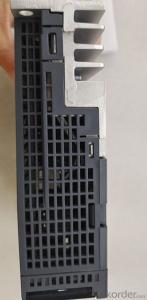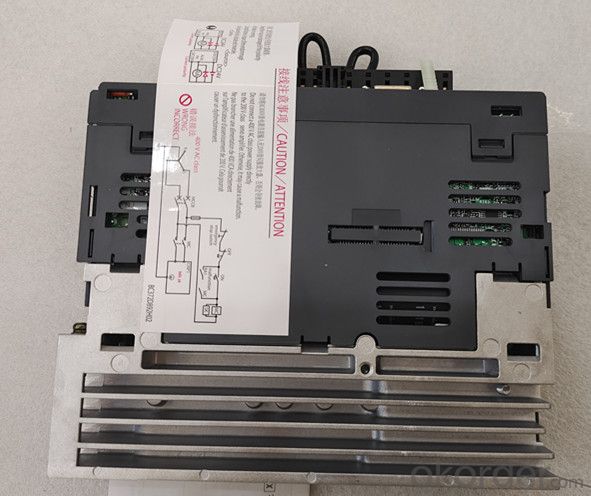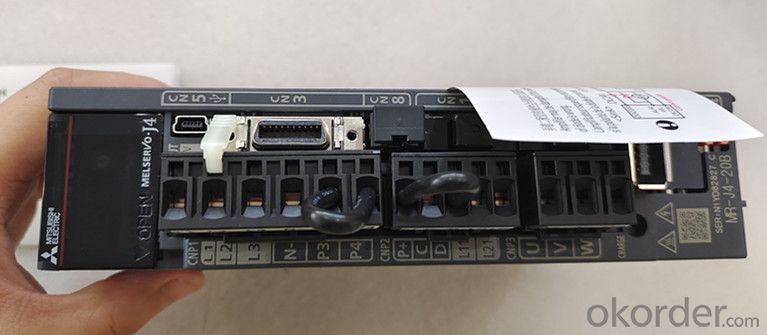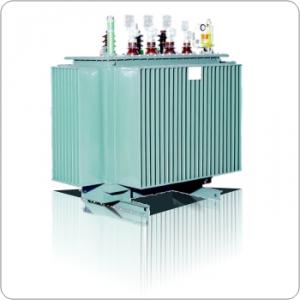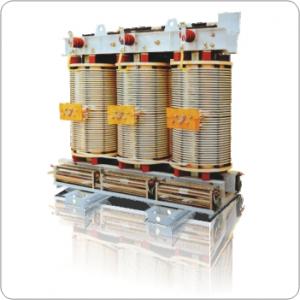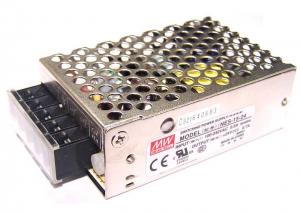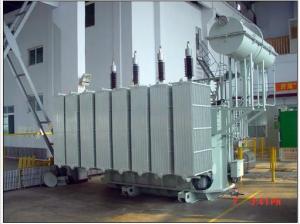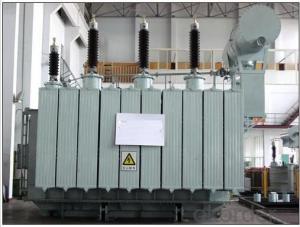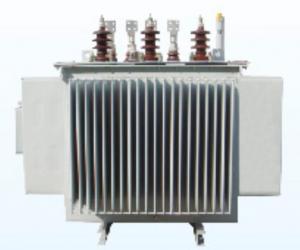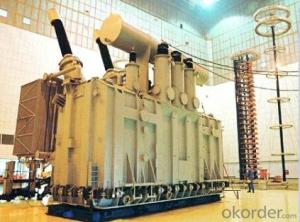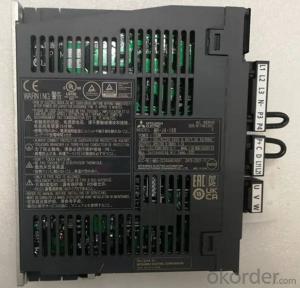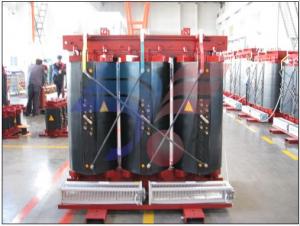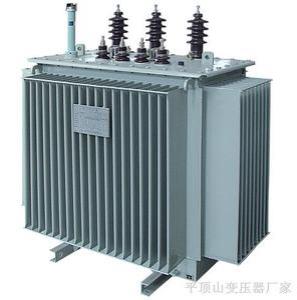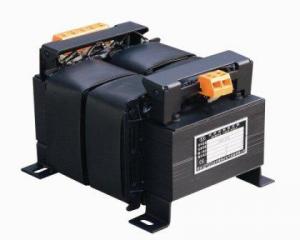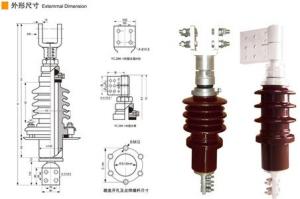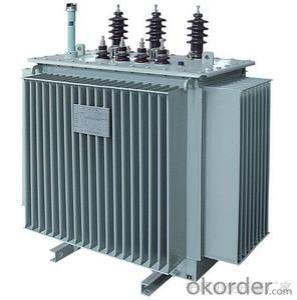Three-Phase Or Single-Phase Universal Type MR-J4-20B Servo Amplifier
- Loading Port:
- Shanghai
- Payment Terms:
- TT OR LC
- Min Order Qty:
- 1 kg
- Supply Capability:
- 2000 kg/month
OKorder Service Pledge
OKorder Financial Service
You Might Also Like
Specification
Specification of sscnetiii / h mr-j4-20b for Mitsubishi servo amplifier 200W:
[output]
. rated voltage: three-phase ac170v
. rated current: 1.5A
[main circuit power input]
. power frequency: three-phase or single-phase ac200v ~ 240V 50Hz / 60Hz
. rated current: 1.5A
. allowable voltage variation: three-phase or single-phase ac170v ~ 264v
. allowable frequency variation: ± 5%
. capacity of power supply equipment: 0.5kva
. surge current: 30A (reduced to about 3A after 20ms)
[control circuit power input]
. power frequency: single phase ac200v ~ 240V 50Hz / 60Hz
. rated current: 0.2A
. allowable voltage variation: three-phase or single-phase ac170v ~ 264v
. allowable frequency variation: ± 5%
. power consumption: 30
. surge current: 20 ~ 30A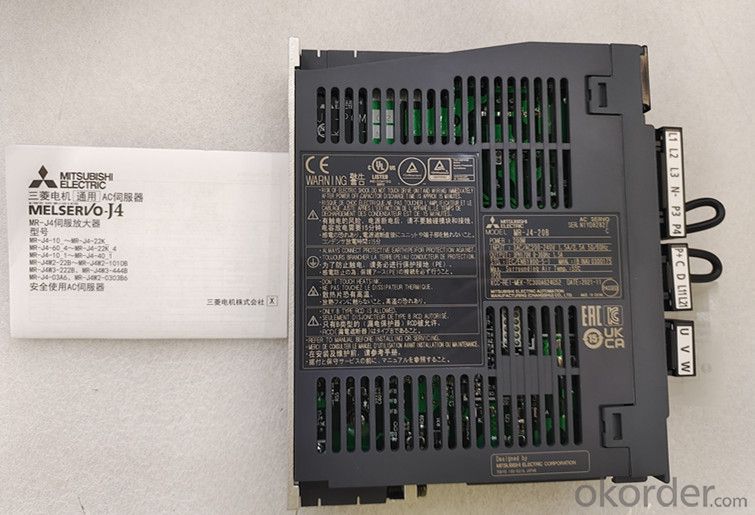
[power supply for interface]
. voltage? Frequency: DC24V ± 10%
. power capacity: 0.3A (including CN8 connector signal)
[control mode] sine wave PWM control current control mode
[dynamic brake] built in
[communication function]
. USB: connection with personal computer, etc. (corresponding to Mr
configurator2)
[position control mode]
. maximum input pulse frequency: 4mpps (differential input), 200kpps (open
collector input)
. positioning feedback pulse: encoder resolution (resolution of servo motor per
revolution) 22 bits
. command pulse magnification: electronic gear A / b times a = 1 ~ 16777216, B
= 1 ~ 16777216, 1 / 10 < A / b < 4000
. positioning completion pulse width setting: 0pulse ~ ± 65535pulse (command
pulse unit)
. excessive error: ± 3 Revolutions
. torque limit: set through parameter setting or external analog input (dc0v ~
+ 10V / maximum torque)
[speed control mode]
. speed control range: analog speed command 1:2000, internal speed command
1:5000
. analog speed command input: dc0v ~ ± 10V / rated speed (the speed at 10V can
be changed through [pr.pc12])
. speed change rate: ± 0.01% (load change: 0% ~ 100%), 0% (power change: ±
10%) ± 0.2% (ambient temperature: 25 ± 10 ℃). Only when analog speed command
is available
. torque limit: set through parameter setting or external analog input (dc0v ~
+ 10V / maximum torque)
[torque control mode]
. analog torque command input: dc0v ~ ± 8V / maximum torque (input impedance:
10K? ~ 12K?)
. speed limit: set through parameter setting or external analog input (dc0v ~
± 10V / rated speed)
[protection function]
Overcurrent protection, regenerative overvoltage protection, overload
protection (electronic thermal relay), servo motor overheating protection
Encoder abnormal protection, regeneration abnormal protection, insufficient
voltage protection, instantaneous power failure protection
Overspeed protection and excessive error protection
[safety function] sto (IEC / en 61800-5-2)
[safety performance]
. third party certification specification: EN ISO 13849-1 type 3 PL D, en 61508
SIL 2,
EN 62061 SIL CL2,EN 61800-5-2 SIL 2
. response performance: less than 8ms (STO input off → energy cut-off)
. test pulse input (STO): test pulse cycle: 1Hz ~ 25Hz test pulse off time:
max. 1ms
[structure (protection level)] self cooling open (IP20)
[compact installation] adjustable
[weight] 0.8kg
- Q: How do I determine if a transformer is beyond the normal temp range and is at risk of failure?A 225 kva installed in 1996 is running hot. I removed the cover and using a digital thermal meter read approx 125 degrees F on each winding. 243 degrees F on the top metal (winding support) frame. It's got parallel 750's off the load side and would be an expensive and difficult change.
- The temperatures you measured seem hot but might be acceptable for the type of materials used to insulate the coil inside the transformer. Only the designer of the transformer could tell if it's too hot or not. One rule of thumb : for non industrial electrical devices, the outside temperature of the device should remain at a temperature that lets you touch it without feeling pain. But one thing is sure: high temperature is not good because the transformer will age faster and it's less efficient (and therefore generates more heat). The transformer can overheat for 2 reasons : either your load is above the nominal rating or the transformer is not able to cool down as designed (usually because it's in an enclosure which doesn't let the heat get out). If you are indeed getting 750kva from it, then you are definitely at risk. That's more than 3 times the nominal rating. I would be surprised that it lasted for so long. If you can't reduce the load (best option), try to let more air flow freely around it by removing stuff around it. Last resort try cooling it down by forcing cool air to flow around it with a fan. But this can be tricky because the bottleneck of the heat exchange could be inside the transformer so the outside might get cooler and the inside could remain very hot.
- Q: I like to construct an autotransformer . Input voltage .240Vsingle phase. to use in a system whose operation voltage is 120v. 15 amps 1000 watts can some suggest me as to how i should proceed in calculating size of core ,winding turns, wire sizes etc , now i have 4 inches square E type transformer core . I removed all windings from it. It was used in a microwave .
- If the microwave transformer has a 240 volt primary winding, count the turns and use the same number of turns for the autotransformer. If it has a 120 volt primary, use twice as many turns as the original transformer. Half of the turns will carry only the primary current. The wire for those turns should be about the same size as the original wire if the primary was 240 volts or half that size if the original primary was 120 volts. The remaining turns need to be about three times the size of the first half of the turns.
- Q: i have plenty of 3 phase 220 in my shop, but one of my machines requires 440 3 phase. i was going to use a 75 kva transformer with 440 primary 220 secondary in reverse to supply the machine. it is a 15 hp motor 40 amps. i figured my minimum kva requirment to be 37.5 but more cant hurt for the potential high cutting rates i may need to achieve. i simply wanted to buy the transformer, hook the 220 3 phase supply to the primary, and the output to my machine. I think this will provide me with 440 output. the motor plate says 7-1/2 hp/15- hp. 40/20 amps. Any help is welcome, i hate to buy the transformer and not have this unit work. i would change the motor wiring, but the diagram is gone, and the wires are not numbered, also i believe id have to change all the heaters, which are hard to come by, as well as various other parts in the panel. just seems the transformer is the easiest way to get this machine up and going in prouction.
- transformers can either be step up or step down, it will surely work.
- Q: Are there any transformers action figures that arent for little kids like from the movie and are collectables? LINKS?
- Personally I wouldn't go with the ones from the movie. They're more a kids toys and the quality isn't too good. I go with G1 reissues. The Binaltech and Alternators line. Fun to play with and has collectible value. And the Masterpiece Edition Transformers. Which i do recommend highly. Expensive but worth it. The details look very real. And are collectors items The classics line is good too. They look a lot more decent and a bit better in quality than the current toys.
- Q: How do I choose a transformer? The
- Select the transformer, you can not choose too large, can not choose too small According to the following method to select the transformer capacity. ???There is a very important data is not provided, is the load at the same time coefficient. Transformer with the actual load and equipment rated power ratio is called the transformer load factor. The concept of the load factor for the load is the probability that the load is used at the same time, also called the coefficient or the simultaneous coefficient, which is the probability of simultaneous use of the device. The total load is 300kw, but they are used at the same time there is a probability that the probability is the load factor. It is impossible to always use at the same time. Of course, you can according to the actual situation to calculate their own, power factor selected 0.80. ??With this formula, s = p * kX / cosφ Transformer capacity s = device rated power p × transformer load rate kx / power factor cosφ = (300 × kX) × 0.80 This is the transformer capacity. ???Do not know what the motor is used under the circumstances, so it can not be calculated, and only calculate the same time after the generation of the formula into the above formula. If the coefficient is 0.9, then the results of about 340 kVA, are used at the same time, that is, 375KVA, consider a certain margin and spare capacity, that can choose 400KVA. In addition to the above considerations, in particular, consider the motor starting current factor, select the transformer more reliable. As far as possible by the big do not rely on small. And the standard capacity of the transformer level 315,400,500,630KVA, 315KVA a little small, 500KVA big and no need. So choose 400kvA it
- Q: I know there has been plenty of Transformers anime over the years, but is there any Transformers manga?
- Have you tried googling it? Good luck! I remember seeing Transformers in JPN since I was little I think they've been around since the 80s. At least I've seen the toys in JPN since then.
- Q: I'm 13 and I love the Transformers movie, TF Animated and TF Armadaactually, those are the only ones I HAVE seen so farI'm just wondering where to start with attempting to watch them all? And in what order? Or, doesn't it matter? I suppose it does with G1 and 2Where on the internet can I watch them? Any recommendations?Please answer! I really want to have seen every one!
- not okorder
- Q: How to build inverters using ferrite core transformers, details assemblies.
- Transformers are only tangentially related to inverters. You don't need a transformer to make an inverter. At its most basic level, an inverter is just a couple of switches. This kind of simple inverter will only output a square wave with amplitude equal to the dc voltage input. To get a sine wave, you would filter the output with a capacitor and an inductor, and to change the amplitude of the wave, you would use a transformer (or alternately place a boost/buck converter before the inverter). If you're going to use both an LC filter and a transformer, you can save on parts by using the magnetizing inductance of the transformer as the inductance of the LC. This is all well and good, but it takes a lot of math and analysis to actually size all of the components. If you're really serious about this, you should find a good textbook and read up on everything.
- Q: Will the 250KVA, 500KVA, 630KVA Van transformer size,
- Box transformer inside the configuration is not the same, the size will be different, which factory production size is not the same
- Q: explain the role of both types of transformers in getting electric energy from an electric power plant (coal-fired, natural gas or nuclear) to our homes.
- The voltage is transformed up to thousands of volts and low current for minimum heat loss in the wires. Then down to low voltage at high current to the neighbor hood.
Send your message to us
Three-Phase Or Single-Phase Universal Type MR-J4-20B Servo Amplifier
- Loading Port:
- Shanghai
- Payment Terms:
- TT OR LC
- Min Order Qty:
- 1 kg
- Supply Capability:
- 2000 kg/month
OKorder Service Pledge
OKorder Financial Service
Similar products
Hot products
Hot Searches
